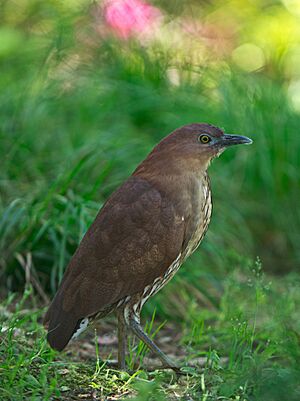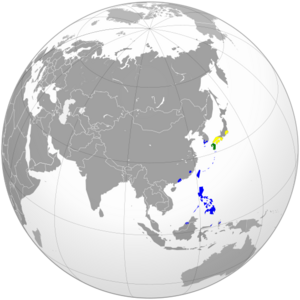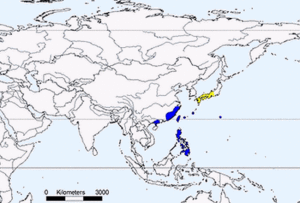Japanese night heron facts for kids
Quick facts for kids Japanese night heron |
|
|---|---|
 |
|
| Conservation status | |
| Scientific classification | |
| Genus: |
Gorsachius
|
| Species: |
goisagi
|
 |
|
| Distribution map | |
| Synonyms | |
|
Ardea goisagi Temminck, 1836 |
|
The Japanese night heron (Gorsachius goisagi) is a special bird found in East Asia. It's a type of night heron. These birds spend their summers in Japan. When winter comes, they fly to warmer places like the Philippines and Indonesia. You might also spot them in Korea and the Russian Far East during spring and summer.
These herons love thick, damp forests. They need these forests for both breeding and wintering. Sadly, their homes are disappearing. Forests are being cut down for wood and farms. This is a big problem for the herons. Also, new animals like the Siberian weasel have been brought into their homes. Crows also eat their eggs and babies.
Because of these dangers, there are fewer than 1,000 adult Japanese night herons left. This makes them a protected species in Japan and Hong Kong. People are working to save them. They want to study the herons more. They also want to protect their homes and teach people about these amazing birds. Stopping new animals from harming them is also important.
Contents
Where Do Japanese Night Herons Live?
The Japanese night heron usually lives in thick forests. These forests are often found on hills and low mountains. They are always close to water, like rivers and streams. This is true for both their summer and winter homes.
They usually live at heights between 50 and 240 meters. But sometimes, they are found much higher. In Japan and the Philippines, they can be over 1,000 meters high. In winter, they hide in dark, shady forests near water. These spots can be as high as 2,400 meters.
What Does a Japanese Night Heron Look Like?
The Japanese night heron has a wingspan of about 43 to 47 centimeters. Their feathers change color as they grow. Adult herons have reddish-brown feathers on their head and neck. Their wings are dark brown.
Young herons have more black on their heads. Their wing feathers are lighter than the adults'. Both young and adult herons have a wide beak. They also have yellow skin around their eyes. A cool thing about this heron is the dark, wavy lines on its wing feathers.
What Do Japanese Night Herons Eat?
Japanese night herons usually eat at dusk, when the sun goes down. They often hunt alone or in small groups. They rarely hunt in open areas. Their food mostly comes from the forest floor. They eat things like earthworms, snails, and small insects.
They use their strong, thick beaks to dig for earthworms and snails. They seem to pick older, harder snails. This might be to avoid eating soft, young snail shells by mistake. While they get most of their food from the ground, they also hunt. They catch small crabs and fish in shallow water. You can find them doing this near swamps and rice fields.
How Do Japanese Night Herons Travel?
The Japanese night heron spends its winters mostly in the Philippines. But you can also find them in other East Asian countries. These include Korea, southern China, Taiwan, and Russia. They fly to their breeding spots in Japan between March and June. Then, they leave Japan between September and November to go to the Philippines.
These herons often travel in large groups. They might fly with over 1,000 other herons. This can include birds like the black-crowned night heron. Japanese night herons are very good at migrating long distances. Sometimes, they even fly past the Philippines. They have been seen in Indonesia and Palau!
Japanese Night Heron Reproduction
There has only been one report of a Japanese night heron breeding in Taiwan. They usually breed in Japan. This happens from May to July, depending on when they arrive. The herons build their nests high up in tall trees. They can be as high as 20 meters. They like trees like cedar, cypress, and oak.
They usually nest alone. Their nests are made of sticks piled together. They also add lots of leaves. The nests are built flat on a branch. Female herons lay 3 to 5 eggs each breeding season. The chicks do not hatch all at once. This is because the parents start sitting on each egg as soon as it's laid.
When the chicks are three days old, the parents leave the nest for 7 to 9 hours to find food. After 20 days, the parents come back once or twice a day. They visit more often as the chicks grow. The young herons leave the nest after about 35 to 37 days.
Why Are Japanese Night Herons in Danger?
The biggest danger to the Japanese night heron is losing their forest homes. Many lowland forests are being cut down. This is often to make space for farms. This harms where the herons live and find food. It also affects where they build their nests.
Also, more and more crows are in the area. Crows often eat the eggs and young of the night herons. Since 1901, Siberian weasels have also caused problems. These weasels hunt fish and insects, which are also food for the herons. This means the herons have less food. All these things have caused a big drop in the number of Japanese night herons.
How Are We Helping Japanese Night Herons?
The Japanese night heron is very rare. This is because they have a small area where they breed. Their numbers have dropped a lot in the last ten years. Because of this, Japanese and Hong Kong laws protect them. Many plans are being made to help them. The goal is to stop their numbers from falling and help them grow again.
These plans include making more people aware of the herons. They also want to study where the herons live during different seasons. Controlling the sale of these birds is also important. Finally, they are working to stop new animals that harm the herons from spreading.
See also
- Night heron
- List of birds of Japan



